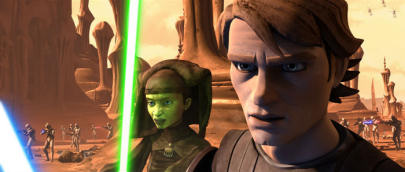Following on from the Clone Wars episode Landing at Point Rain, Weapons Factory continues to highlight the rather unorthodox methodology of Jedi Knight Anakin Skywalker. There is a fundamental disconnect between Anakin’s understanding of right and wrong and that of the Jedi Order, and in the final minutes of this episode, we see just how great that disconnect is.
With the mission to destroy the shield generator a success, it’s now up to Anakin and Ahsoka to destroy the Geonosian droid foundry itself. With the addition of Jedi Master Luminara Unduli and her Padawan, Barriss Offee, the group decide to split-up: Anakin and Luminara will distract the Geonosian forces with a rather straightforward configuration of troops while Ahsoka and Barriss sabotage the foundry from within.

Luminara Unduli and Anakin Skywalker team-up on Geonosis
But, as obliquely hinted at with this episode’s fortune cookie (“No gift is more precious than trust”), Anakin is unsure about the idea of the two Padawans being given such responsibility. The notion of “trust”, however, is a red herring: Anakin is simply uncomfortable with losing control of Ahsoka and allowing her a degree of autonomy.
From the very first moments of Weapons Factory, Anakin undermines Ahsoka at every opportunity, not once giving her the opportunity to grow as a leader or as a Jedi. By allowing Ahsoka to grow, Anakin risks losing the relationship they’ve formed. Like the Mother personality in Alfred Hitchcock’s Psycho — keeping her son, Norman, as unnaturally frozen in time as the stuffed animals that adorn his office — Anakin cannot allow Ahsoka to mature, for if he does, he loses the child he now cares for.
This then manifests as a rather paradoxical Master/Padawan relationship. Anakin must at once keep Ahsoka in the role of “child” and yet, simultaneously, he must be sure not to mentor her too well, lest she “grow up”. The result is a kind of “big brother” role, where doesn’t so much mentor as hector.
It is not surprising, then, that when Barriss first encounters the pair, they are (rather publicly) at each other’s throats, behaving more as out-of-control siblings than as in-control master and apprentice. Luminara and Barriss, on the other hand, present as calm and respectful of each other’s role in the relationship. The styles of Anakin and Luminara are like night and day.
And so once the two Padawans inevitably become cut-off from the group, the differences in approach between Anakin and Luminara are truly apparent. Luminara remains calm, having made peace with either possible outcome; Anakin, meanwhile, becomes belligerent, mistaking Luminara’s enlightened detachment for cold-hearted indifference.

Ahsoka Tano and Barriss Offee prepare to enter the catacombs of the droid foundry
Anakin’s attitude represents a complete misreading of both Jedi and, in our world, Buddhist philosophy. It’s not that you don’t care or turn a blind eye to the suffering of others, but rather that you accept that death is necessarily a part of life — no amount of wailing and gnashing of teeth will change an outcome, whatever it may be. You can (and should) be an active force for good in the world, just as the Jedi are, and yet still be willing to accept that life itself is a grand work of art, and both joy and sorrow, comedy and tragedy, give the finished, rendered piece its beauty.
“It’s not that I gave up, Skywalker, but unlike you, when the time comes, I am prepared to let my student go,” Luminara tells Anakin. “Can you say the same?”
Whether Ahsoka eventually dies, graduates or turns to the Dark Side (as unlikely as that may be), I think we all know the answer to Luminara’s rather pointed question.










